Illustrator Rafael López on The Day You Begin
 September 26th, 2018 by jules
September 26th, 2018 by jules

Illustrator Rafael López visits 7-Imp today for an art-filled discussion about his illustrations for Jacqueline Woodson’s The Day You Begin (Nancy Paulsen Books, August 2018). I mentioned this book in a recent Kirkus column as being a wonderful back-to-school title, but it’s a book to share with children any day of the year, this story of how our differences make us special. Centered in a school room, readers meet Angelina. “There will be times when you walk into a room,” the book opens, “and no one there is quite like you.” It’s a story of making connections and finding one’s voice, but it’s more, as Rafael explains below. It’s about accepting people as they are.
Let’s get right to it, since Rafael shares so generously below. I thank him for sharing today. (If you want more of Rafael’s art, his 2011 breakfast interview here at 7-Imp is one of my favorites.)
Jules: Hi, Rafael! What was your initial response to Jacqueline’s text?
Rafael: Jackie had me at the first line, “There will be times when you walk into a room and no one there is quite like you.” The first time I read the manuscript, I was sitting in the kitchen with a cup of coffee after dropping my son off at school. When reading, I instantly saw pictures. We all want to fit in and find our place. There was an authenticity to her words that stuck in my throat. It was all there — the self-doubt, struggle, tenderness, and triumph of personal discovery.
This story triggered memories. I couldn’t help but see myself, my own child, and, for that matter, many children in her story. When my family moved to the border, I became part of a Rotary exchange program. I lived in the Midwest for a time and saw myself in [the character] Rigoberto, as I struggled to learn English and fit into a new country. All my life, I was always the last one picked for sports teams and so found comfort in music and art.

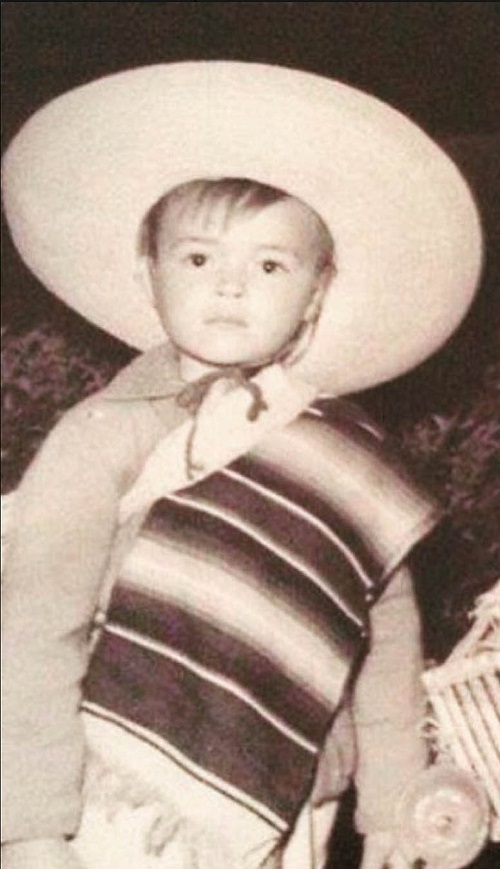

Jacqueline’s powerful text lit a bright light. I was sure kids who felt alone would find warmth and comfort in her reassuring words. She had crafted a story that children could both relate to and translate into their own voice. For me, this made all the difference. I was determined to do my part in this collaboration to bring visual voice to her encouraging message.
Jules: A little bird told me you drew inspiration for one of the students in the book from your own experience watching your son acclimate to school. Can you talk more about that? Is it the beautiful “And all that stands beside you is your own brave self” spread?

steady as steel and ready even though you don’t yet know
what you’re ready for.”
(Click to enlarge spread)
Rafael: I have been waiting for that right moment, the right story, to speak in pictures about something very close to me. Our son, Santiago, has high-functioning autism.
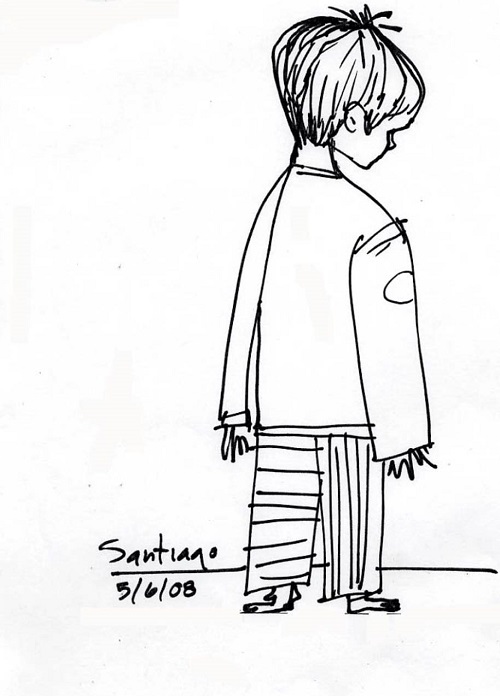
When he was small, he struggled to find his words, and with his drawings he tried to communicate that. Whenever our son drew people, animals, or suns he always wired their mouths shut. Eventually, after seeing this in so many of his drawings, it clicked. We reached out to discover what he was so clearly telling us with his art.
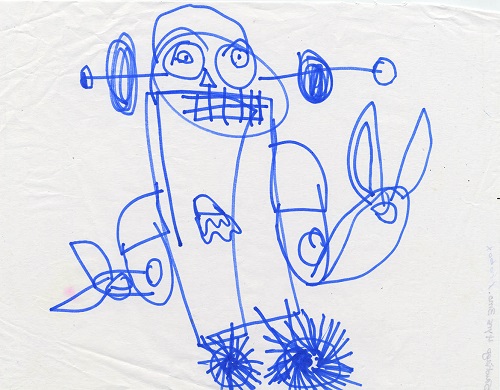
Santiago’s clever drawings led to his autism diagnosis, and the sometimes painful yet remarkable journey of our family began. When our son knew we understood at last, all the wires on the fantastic creatures and humans in his drawings vanished and were replaced with smiles.
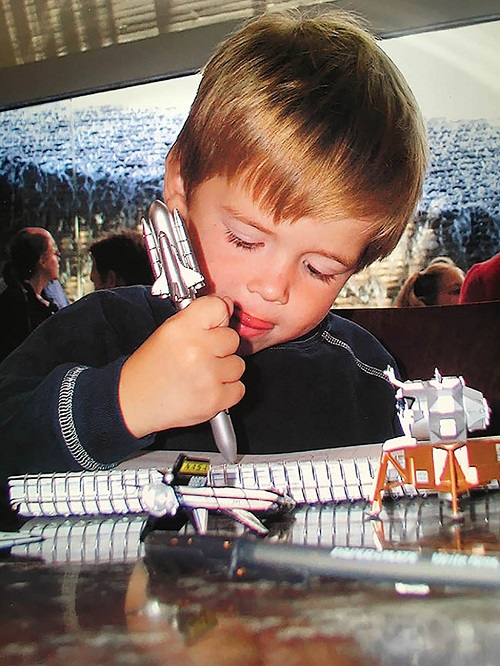
I encouraged him to play with others on the playground or in parks, and after a while I realized he was happier studying the details of flowers and insects or studying images in books. As Santiago found his words, he let us know that he sees things differently.
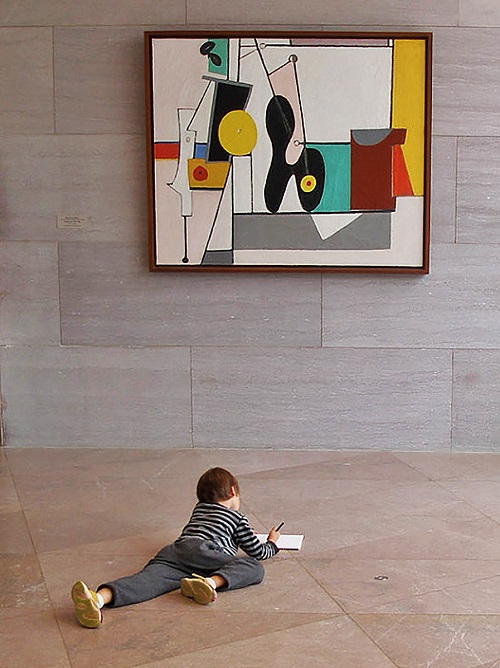
“And all that stands beside you is your own brave self…” was my chance to reveal the hope that springs from the spirit of young people who choose to share their stories — in their own way. The world needs unique perspectives, and history has shown that, given a chance to learn and grow, a different mindset can make a difference.

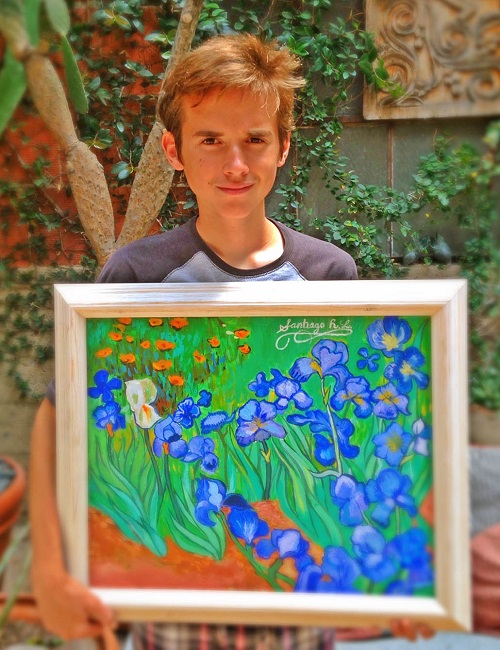
Now that The Day You Begin is out, I’m receiving mail from parents and grandparents letting me know that someone in their family has autism. They want me to know their child saw something familiar in that character. I decided to not show this character on the final page of the book but instead show his joy and inner strength in that reflection. Santiago has taught me there are many ways to connect to others by sharing our stories in our own way.
I’m hoping readers will ask questions and interpret the images from their perspective. There are many possible reasons why a classmate might choose to be alone or like it. Maybe they are shy, not athletic, or struggle with a disability or with issues like homelessness or language. Whatever the reasons, every child has a story to tell — and that story matters.
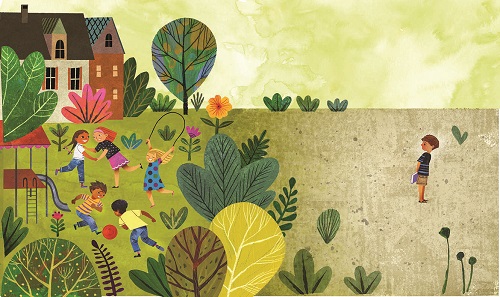
that you’re standing all the way outside of …”
(Click to enlarge spread, which is sans text)
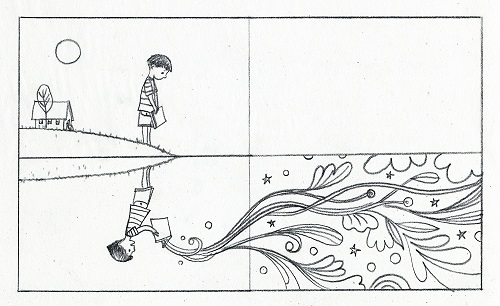
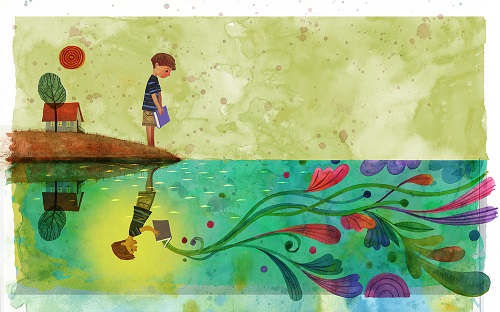
(Click each to enlarge)
Jules: Tell me about the ruler-as-a-door in the first spread (and the ruler-as-table and tree that show up later).
Rafael: Growing up in Mexico City, I am no stranger to the magic of surrealism. If you know where to look, you’ll find it beyond the doors of museums, on street corners and hidden everywhere you turn. Kids are curious, and in my books I like to use many metaphors. It’s fun to embed visual clues and leave a trail for young readers to follow. As kids revisit the book, my hope is they will discover new things they missed the first time. Every time they open the pages, it’s a new experience. I hope readers will ask questions — what does it mean and why it is there? — and then answer in their own voice, as they keep turning the pages.

and no one there is quite like you.”
(Click spread to enlarge)
Just as Jackie skillfully tackled challenging situations with her words, I tried to use expressions and gestures to address the fear, anxiety, and self-doubt of measuring up to others. It was also important to visually create that spark of hope to encourage young readers to find the strength in each of the characters of the story.
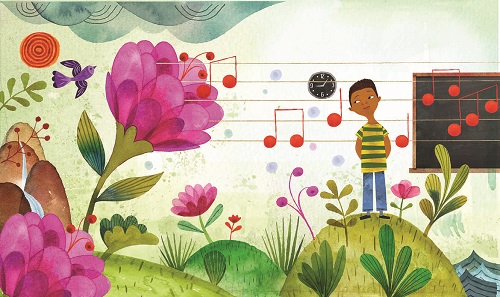
(Click to enlarge spread, which is sans text)
Jules: There are many birds in this book. What do they symbolize to you?
Rafael: I keep birds close to my art, because they are part of both earth and sky. Birds have a creative role in this story, reinforcing connections that can be found throughout the book. As one example, for Rigoberto birds symbolize the sweetness of memories, the sounds, the smells and sights of his native country Venezuela. When Angelina recalls staying at home to care for her little sister in summer, flying birds outside her window represent different adventures, real and imagined.
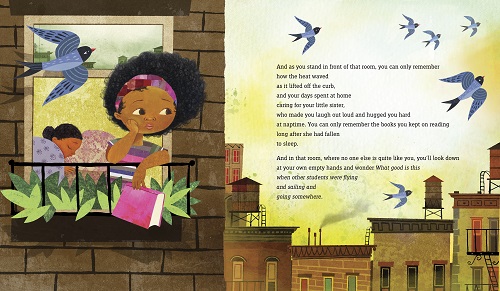
who made you laugh out loud and hugged you hard …”
(Click to enlarge and see text in its entirety)
When she finds the courage to open up and share her stories, birds soaring are a metaphor for the power of books to take you places. When Rigoberto and Angelina find common ground, a bird shows that initial spark of connection. On the final image with three friends playing in leaves, the birds represent us, the readers, contemplating the calm scene of joy.
Here is the evolution of that illustration …


(Click to enlarge)
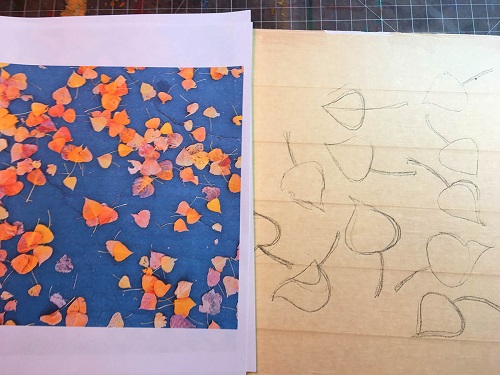
(Click to enlarge)
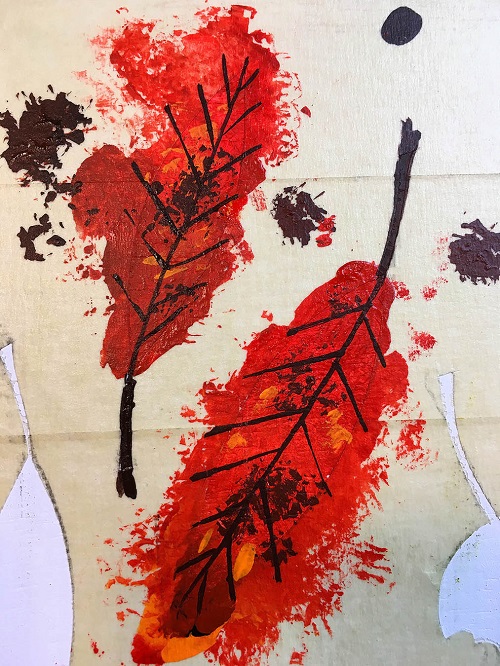
(Click to enlarge)

(Click to enlarge)
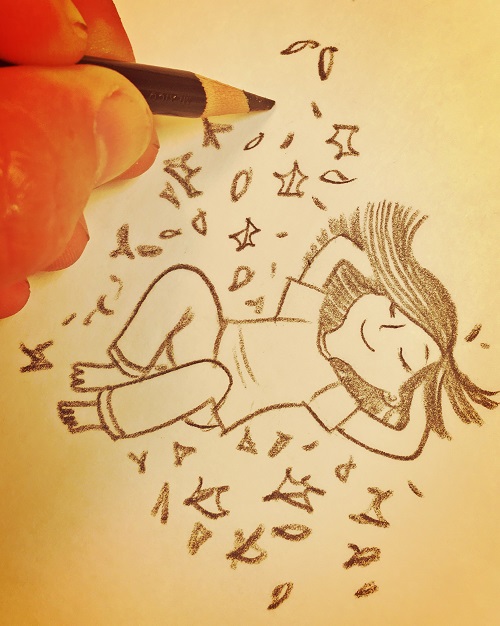
(Click to enlarge)
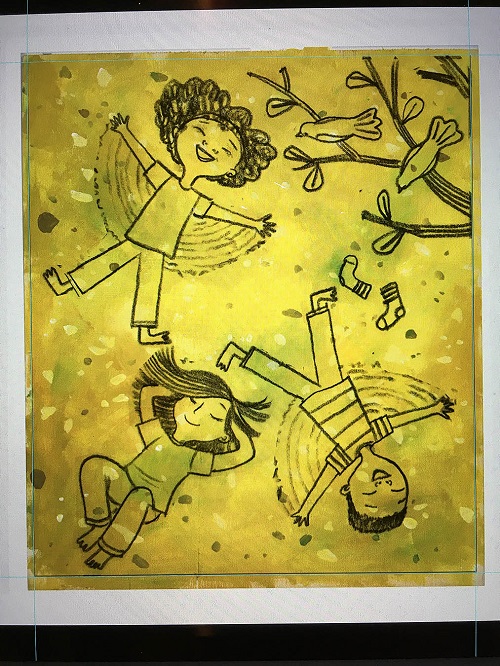
(Click to enlarge)
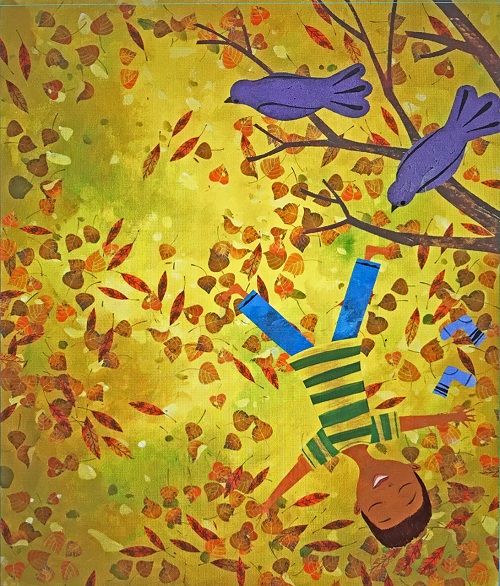
(Click to enlarge)

(Click to enlarge)
Jules: Can you talk about the mixed media used to create the artwork?
Rafael: Each new book challenges me to try something new. I search for the right materials and techniques to express the spirit of the text. The Day You Begin is about our differences, sharing our stories and connection. I instinctually knew that I would need mixed media to convey the different emotions and experiences of diverse characters.
For Angelina, our heroine, I painted with acrylic on wood to bring texture to her face. Her blouse is a pattern I found in a vintage book, as I wanted to play up her uniqueness. To convey her introspective free spirit, I was inspired by my amazing architect mom, who grew up in the ’60s. She loved wearing bandanas and still does, and it seemed to express Angelina’s vibrant personality.
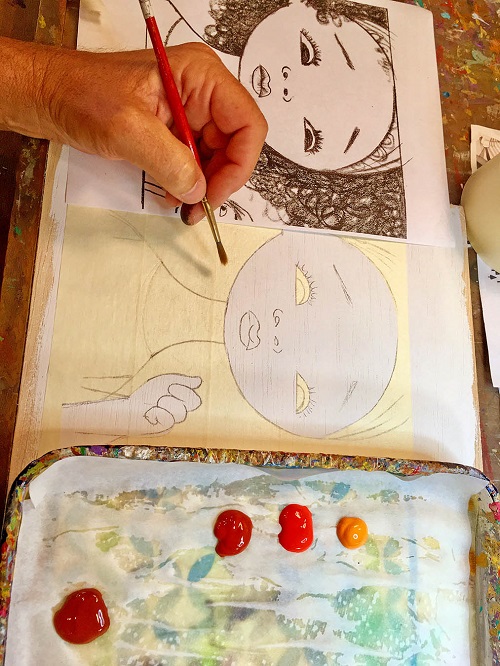
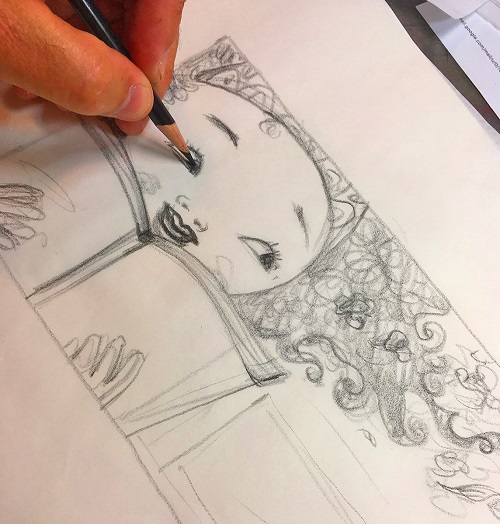

The hair involved a lot of experimentation with mixed media. The base of her hair was acrylic to get the tone, textured with graphite pencil on vellum with shadows added digitally. It’s like meticulously making a sandwich as you bring it all together.
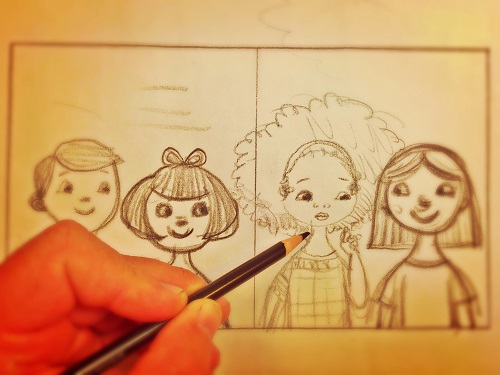
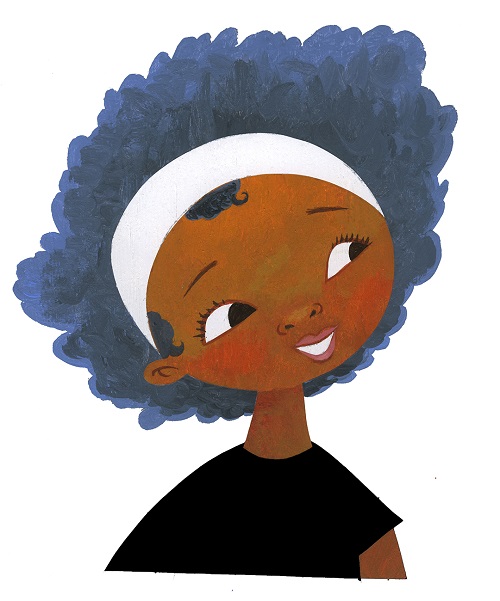
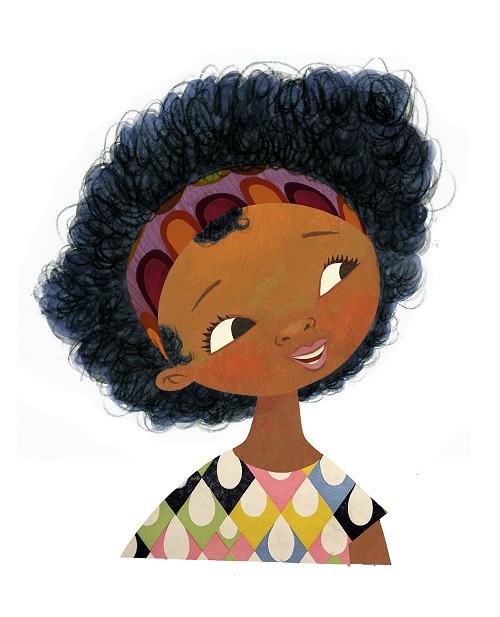

(Click to enlarge)
While traveling to a conference, I took a few hours off to clear my mind before a presentation. I walked to the edge of a small lake in the middle of San Antonio and photographed reflections. I was thinking about the concept for the book at the time and was struck by the idea of seeing your future in a reflection. The character of the boy at the edge of the water is acrylic on wood, but I used watercolor to achieve that ethereal feeling. I whipped wet brushes on watercolor paper to create splatters and the translucency of a dream.

(Click to enlarge)

(Click to enlarge)
Through drawing, you put small pieces of your own experience into the marks you make on paper. Sketching is thinking with my pencil, and I love the graphic quality and confident line that comes from pen and ink. I cut black construction paper to build many of the shapes in stories I illustrate. I’m also drawn to the intuitive handmade textures of acrylic paint on wood boards, as they bring humanity to the page. Then I put things together in Photoshop, as it allows me to place textures and patterns into the art. Working in layers gives you the freedom to bring depth to the visual telling of the story.
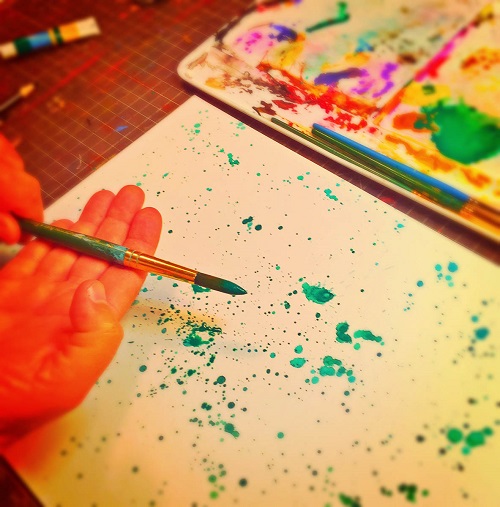
(Click to enlarge)

(Click to enlarge)
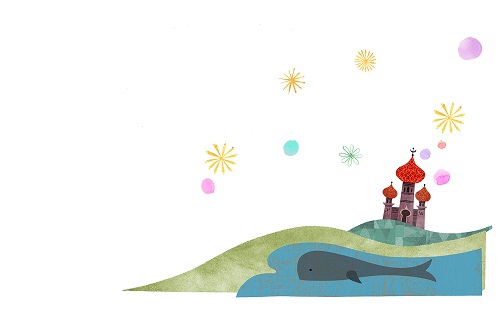
(Click to enlarge)
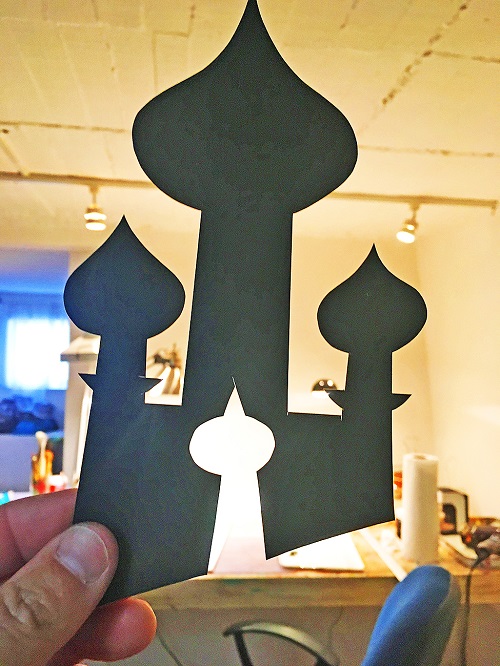
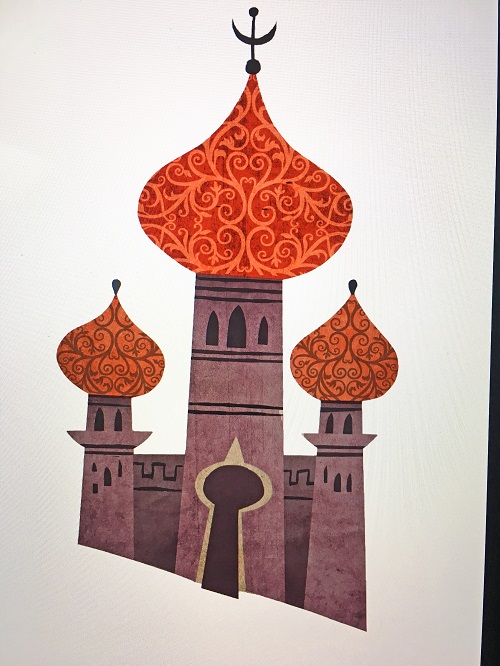
(Click each to enlarge)
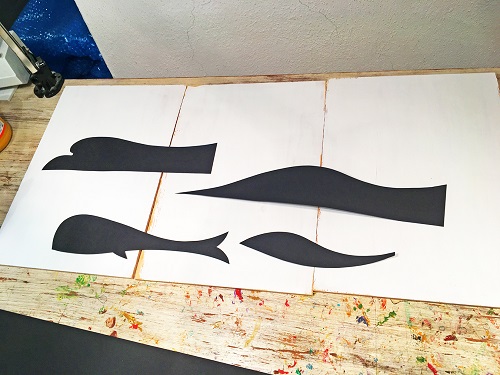
I was given the opportunity to craft original type for the title (in both English and Spanish), because I wanted to bring a touch of the hand to the cover for our book.
Here’s the evolution of the cover …

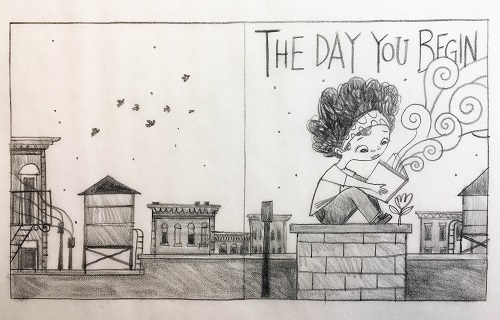
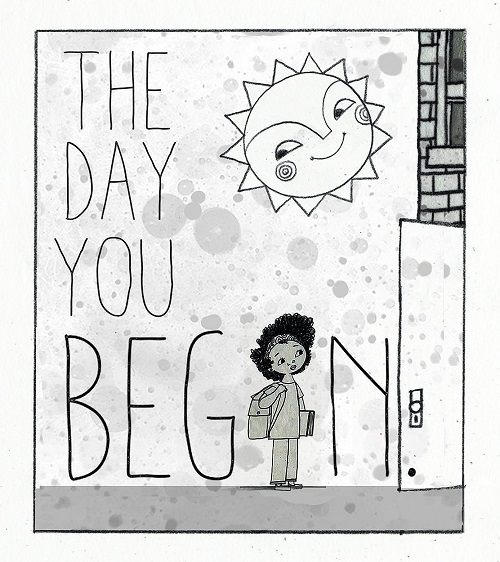
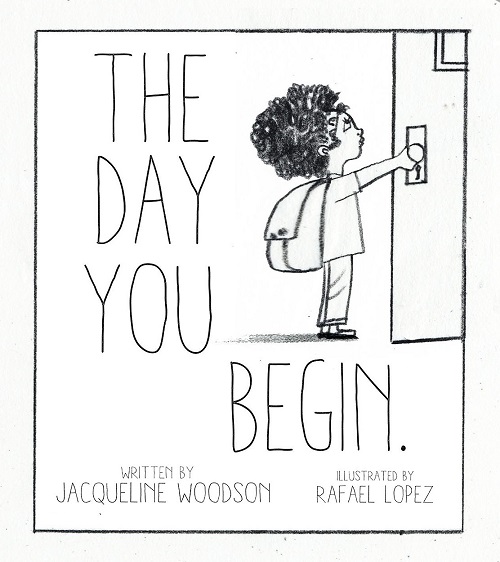
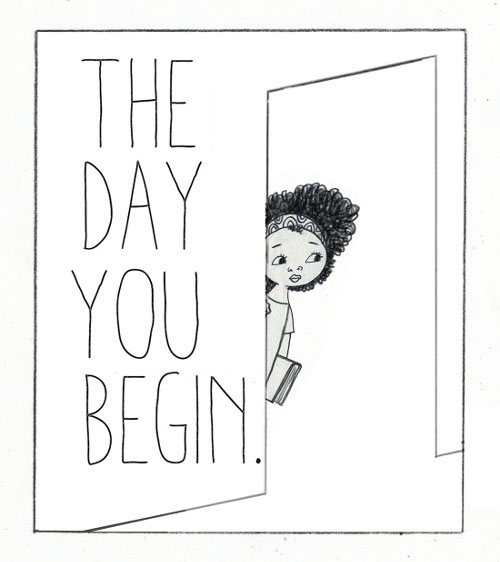

(Click each to enlarge)
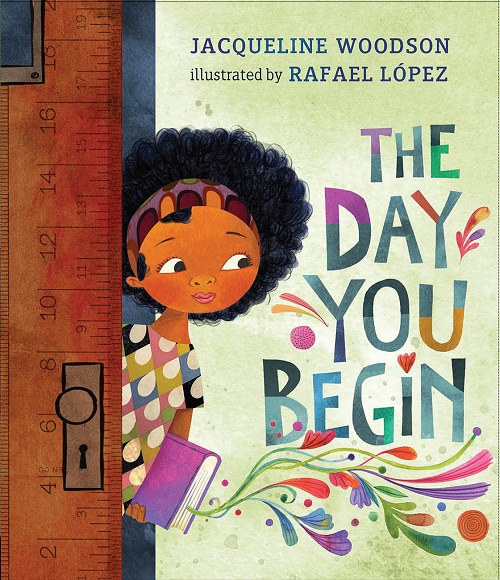
(Click to enlarge)
Creating a book is a collaborative effort that requires lots of back and forth with sketches, concepts, and direction. [Below are] some images that didn’t make the final cut to illuminate the process. Grateful for the opportunity to work with an incredible writer, editor, art director and team who guided this book to the hands of children.
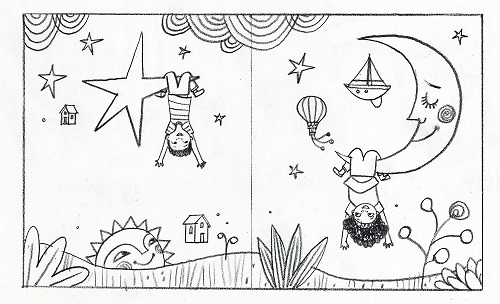
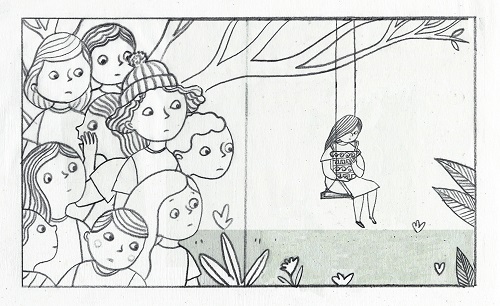
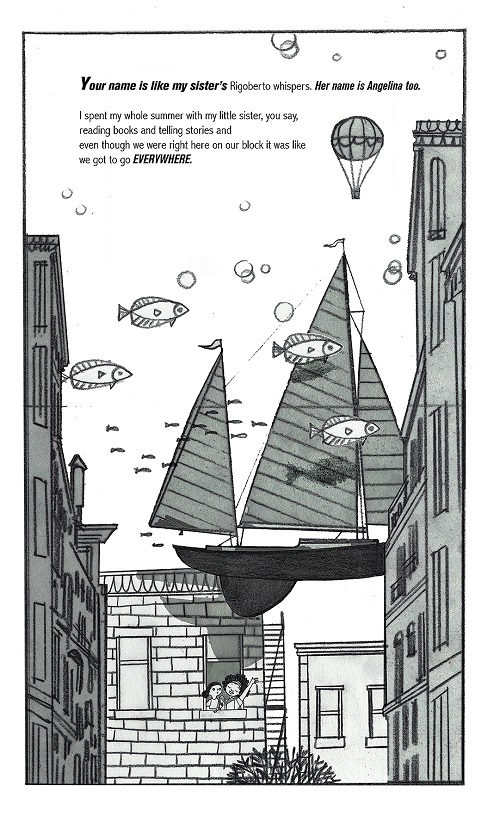

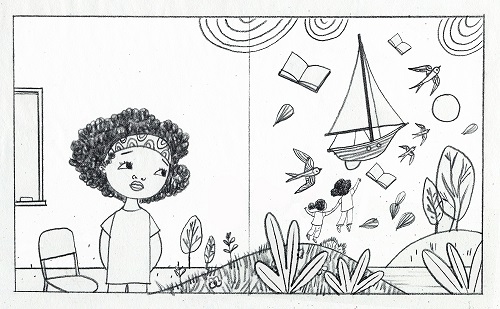
(Click each to enlarge)
Jules again. Many thanks to Rafael for sharing. Here are some more images to close out the post. …
(click each image to enlarge):
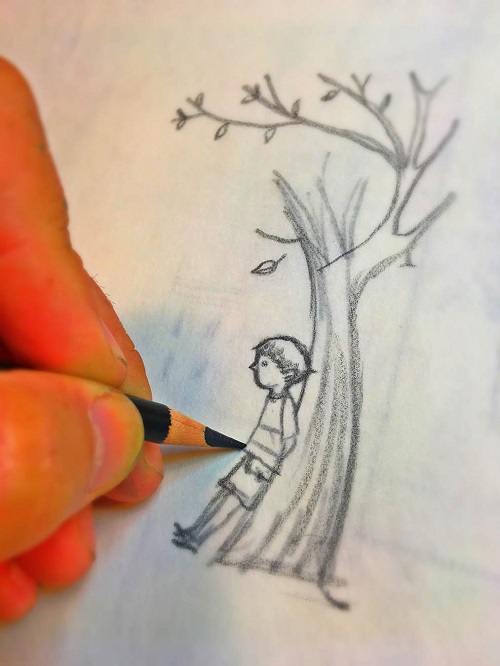


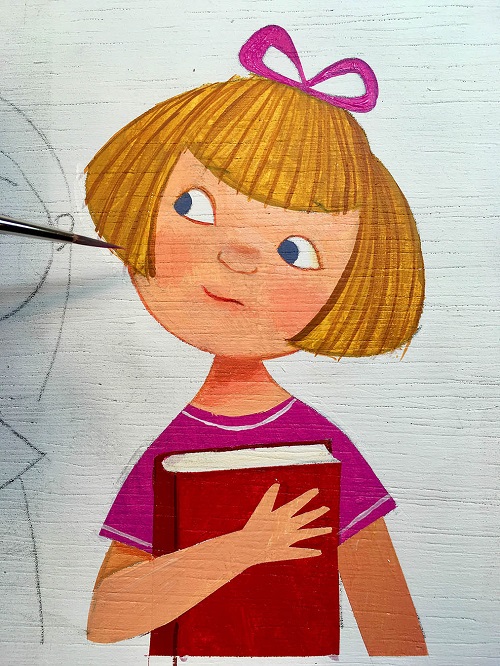
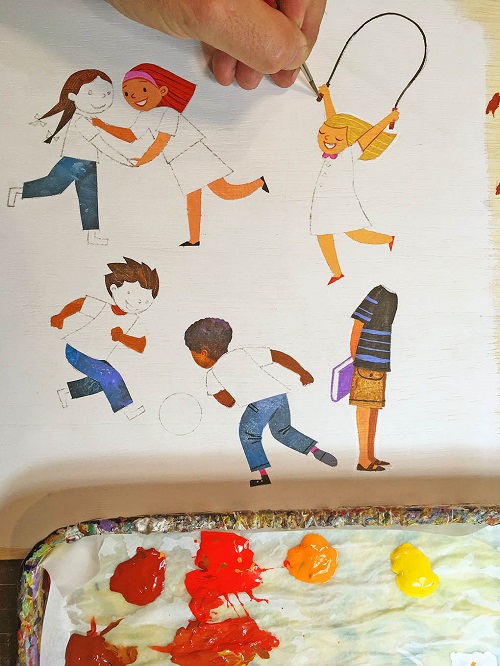
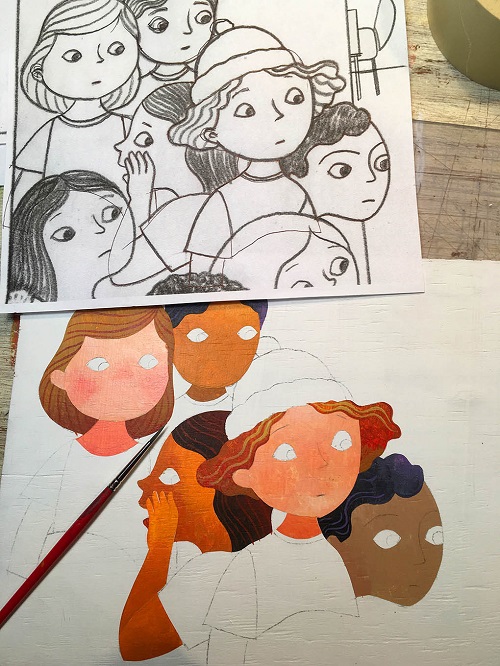
(click each image to enlarge):
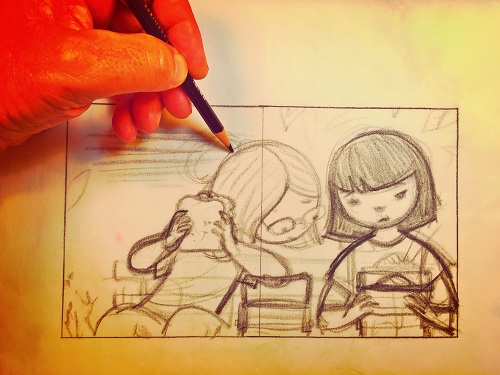
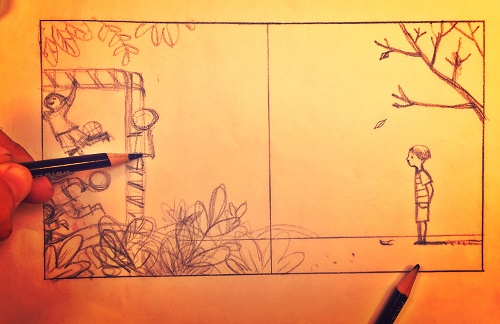


(click each image to enlarge):
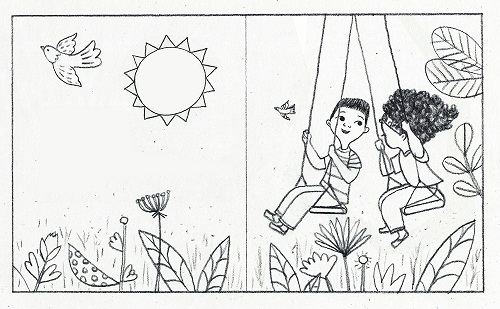


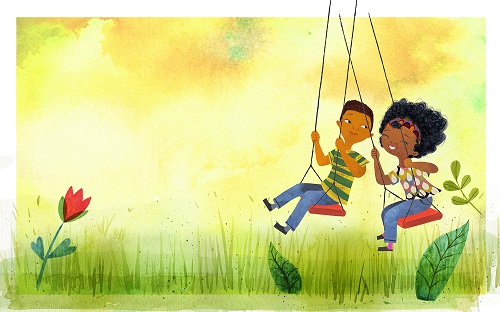
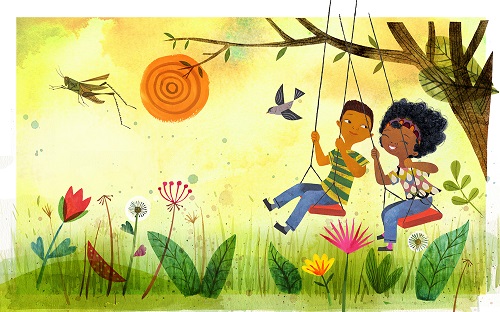
your laughter and your lunches, your books, your travel and your stories,
where every new friend has something a little like you — and something else
so fabulously not quite like you at all.”
(Click image to enlarge)
(click each image to enlarge):
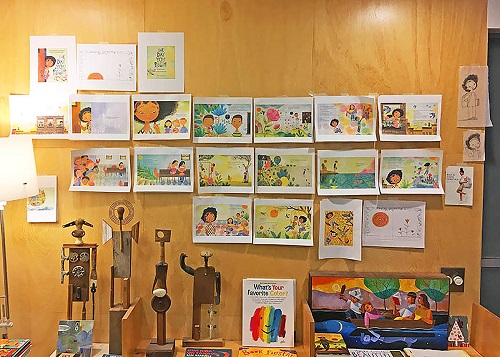
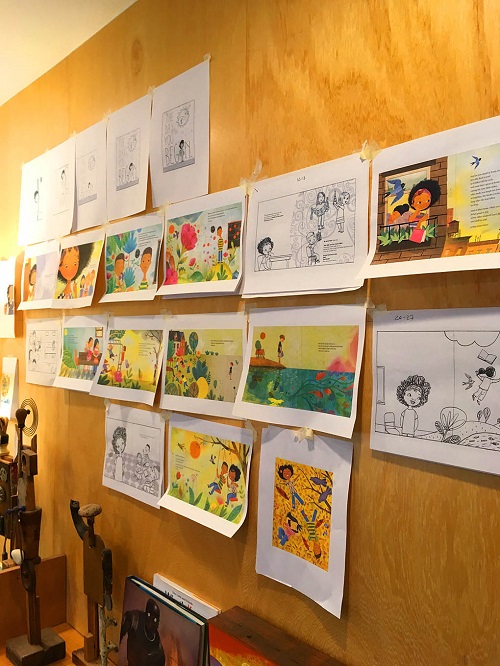
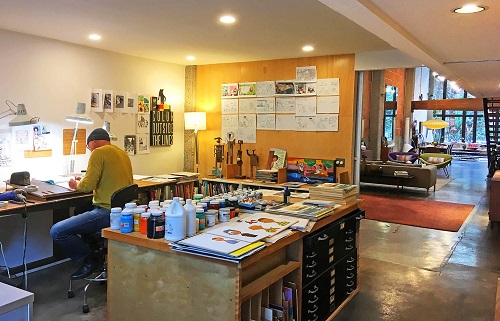
THE DAY YOU BEGIN. Copyright © 2018 by Jacqueline Woodson. Illustrations copyright © 2018 by Rafael López. Published by Nancy Paulsen Books, an imprint of Penguin Random House LLC, New York. All images here reproduced by permission of the publisher and Rafael López.

Once again, an illustrators whose work is so rich it just looks like something you want to …eat. Ingest. Roll around in. All those rich colors and beautiful details. And I LOVE that the story of his precious child is just hiding in the quiet places in his work. This is a book bound for success on the strength of two such bright and beautiful people coming together to make something amazing together.
Magnificent and moving.
I am so proud that you were your self and put your owen words on paper im so impreessed .
This is just so neat to see! Thank you for showcasing this amazing artist!